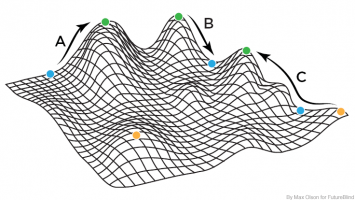Widgetized Section
Go to Admin » Appearance » Widgets » and move Gabfire Widget: Social into that MastheadOverlay zone
Nuzzling Citizens as Public Policy: Reviewing Room’s Agile Actors on Complex Terrains
The views expressed are those of the author and do not necessarily reflect the views of ASPA as an organization.
By Bill Brantley
October 4, 2016
In 2011, Dr. Graham Room released his seminal work on applying complexity theory to public policy analysis. This book greatly influenced my work as policy practitioner in the U.S. federal government. Thus, I was greatly excited to see his latest book, Agile Actors on Complex Terrains, which expands upon Room’s concepts. In this review, I will explain how Room’s books are connected to Room’s concept of public policymaking – “nuzzling.”
Agile Decision Making – The Eight Steps
In Room’s previous book, Complexity, Institutions and Public Policy, he describes the “Agile Policy-Making Toolkit.” This eight-step process aids the policymaker in constructing policy solutions for complex issues. Based on the fitness landscape concept, the agile policymaker firsts maps the specific policy landscape while identifying the protagonists and modeling their struggle on the landscape. The agile policymaker attempts to civilize the struggle by looking for tipping points and energizing the protagonists. The policymaker uses various policy interventions to tune the landscape and to prevent predators from taking unfair advantage of the now civilized struggle.
In developing the agile policy-making toolkit, Room merges both complexity theory with an institutional theory to describe a method for dealing with complex policy challenges. Room does not mention the agile policy toolkit in his newest book, but you can see the influence in his two newest concepts.
Transformative Realism
In the first section of the book, Room examines how actors use micro-actions to produce changes on the macro-scale. The important point is that the macro-scale changes self-organize as in the classic example of Schelling’s research on how segregated neighborhoods emerge. According to Schelling’s research, if a slight majority of actors prefers neighbors just like themselves, neighborhoods will form homogenous clusters. Room argues that this research is a good start but does not take into account how institutions can block some actors from creating macro-changes while empowering other actors to construct significant macro-changes.
Transformative realism is essentially Room’s agile policy-making fitness landscape with its protagonists using their personal micro-actions to gain an advantage on the larger macro-scale of the landscape. The actors have their goals but must also contend with pre-existing institutions and the goals of the other actors. Transformative realism sets the stage for the second section on agile actions.
Agile Actions
Room starts the second section on agile actions with this question: “[h]ow can we make sense of how social actors probe the complex and turbulent landscapes they find themselves?” He examines Popper’s theories and Goldthorpe’s theories on rational actions to examine how actors use their micro-actions to affect macro-scale changes. Room states that purposive-action theories are too linear, as the theories do not account for the interactions between the actors. Actors are constantly probing their environment and readjusting their micro-actions in response to other actors’ micro-actions and macro-scale effects.
Room calls agile actors as “menu-makers” instead of just “menu-takers.” According to Room, menu-takers choose from the existing options available to them on the macro-scale landscape. Menu-makers also act as menu-takers in that menu-makers will choose from existing options – when it suits the menu-maker’s purpose. When needed, the menu-maker will create new options not available on the menu. What limits (or amplifies) a menu-maker’s ability to create new options is a major part of Room’s analysis.
The Vital Role of Institutions
Actors need a safe ground from which to create new options as they continually explore the transformative realism landscape and how their actions influence the landscape. Institutions provide that safe ground in the “settled body of habits and conventions, involving rules of thumb and standard templates.” Actors work in the tension between a “sociology of order” and a “sociology of control.” Under a sociology of order, institutions enforce rules guiding how actors interact with each other while providing the authority behind sanctioned choices. In this case, institutions provide the menu of options from which actors can choose. In a sociology of order, actors are compelled to be menu-takers.
In contrast, a sociology of control allows the actors to become menu-makers. Actors can choose a “multiplicity of institutional terrains” (quoting Room) where the actors can alter the institutions to suit the actor’s purposes. Institutions, Room writes, are “the connective tissue which agile social actors re-weave, as they probe and shape the transformative dynamics of their world.” Room sees institutions as the mediating mechanism in which actors can draw upon contributed mental models of the landscape. Institutions also provide the means for actors to communicate and coordinate with each other as they use their micro-actions to create macro-scale effects.
From Nudge to Nuzzle
Room ends the book by advocating “nuzzling” actors while the actors seek to reshape their landscapes. Nuzzling is beyond the concept of “nudging.” Policymakers use nudges in a choice architecture to help actors make the “right choice” when choosing a policy option. According to Room, nuzzling provides safety to the actors while giving the actors freedom to choose the appropriate micro-actions to bring about the desired macro-affects. Nuzzling can increase citizen engagement because nuzzling involves the citizens in co-creating policy actions. As Room concludes, nuzzling can reclaim the promise of deliberative democracy.
Author: Bill Brantley teaches at the University of Maryland (College Park) and the University of Louisville. He also works as a Federal employee for the U.S. Patent and Trademark Office. All opinions are his own and do not reflect the opinions of his employers. He can be reached at http://billbrantley.com.



Follow Us!